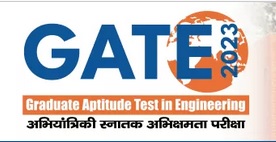GATE Chemistry (CY) Syllabus 2023
Organisation : Graduate Aptitude Test In Engineering GATE
Exam Name : Chemistry (CY) Exam
Announcement : GATE Chemistry (CY) Syllabus 2023
Website : https://gate.iitk.ac.in
GATE Chemistry (CY) Syllabus
In each of the following subjects the topics have been divided into two categories – Core Topics and Special Topics. The corresponding sections of the question paper will contain 90% of their questions on Core Topics and the remaining 10% on Special Topics.
Related / Similar Syllabus : GATE Electronics And Communications Engineering (EC) Syllabus 2023

Chemistry (CY) Syllabus
Section 1: Physical Chemistry
Structure:
Postulates of quantum mechanics. Operators. Time dependent and time independent Schrödinger equations. Born interpretation. Dirac bra-ket notation.
Particle in a box:
Infinite and finite square wells; concept of tunnelling; particle in 1D, 2D and 3D-box; applications. Harmonic oscillator: harmonic and anharmonic potentials; hermite polynomials. Rotational motion: Angular momentum operators, Rigid rotor. Hydrogen and hydrogen-like atoms: atomic orbitals; radial distribution function. Multi-electron atoms: orbital approximation; electron spin; Pauli exclusion principle; slater determinants.
Approximation Methods:
Variation method and secular determinants; first order perturbation techniques. Atomic units.
Molecular structure and Chemical bonding:
Born- Oppenheimer approximation; Valence bond theory and linear combination of atomic orbitals – molecular orbital (LCAO-MO) theory. Hybrid orbitals. Applications of LCAO-MO theory to H2+, H2; orbital theory (MOT) of homo- and heteronuclear diatomic molecules. Hückel approximation and its application to annular π – electron systems.
Group Theory:
Symmetry elements and operations; Point groups and character tables; Internal coordinates and vibrational modes; symmetry adapted linear combination of atomic orbitals (LCAO-MO); construction of hybrid orbitals using symmetry aspects.
Spectroscopy:
Atomic spectroscopy; Russell-Saunders coupling; Term symbols and spectral details; origin of selection rules. Rotational, vibrational, electronic and Raman spectroscopy of diatomic and polyatomic molecules. Line broadening. Einstein’s coefficients. Relationship of transition moment integral with molar extinction coefficient and oscillator strength. Basic principles of nuclear magnetic resonance: gyromagnetic ratio; chemical shift, nuclear coupling.
Equilibrium:
** Laws of thermodynamics. Standard states. Thermochemistry. Thermodynamic functions and their relationships: Gibbs-Helmholtz and Maxwell relations, Gibbs-Duhem equation, van’t Hoff equation. Criteria of spontaneity and equilibrium. Absolute entropy. Partial molar quantities. Thermodynamics of mixing. Chemical potential. Fugacity, activity and activity coefficients.
** Ideal and Non-ideal solutions, Raoult’s Law and Henry’s Law, Chemical equilibria. Dependence of equilibrium constant on temperature and pressure. Ionic mobility and conductivity. Debye-Hückel limiting law. Debye-Hückel-Onsager equation. Standard electrode potentials and electrochemical cells.
** Nernst Equation and its application, relationship between Electrode potential and thermodynamic quantities, Potentiometric and conduct metric titrations. Phase rule. Clausius- Clapeyron equation.
Phase diagram of one component systems: CO2, H2O, S; two component systems: liquid- vapour, liquid-liquid and solid-liquid systems. Fractional distillation. Azeotropes and eutectics. Statistical thermodynamics: micro canonical, canonical and grand canonical ensembles, Boltzmann distribution, partition functions and thermodynamic properties.
Kinetics (Topic has been rearranged):
Elementary, parallel, opposing and consecutive reactions. Steady state approximation. Mechanisms of complex reactions. Unimolecular reactions. Potential energy surfaces and classical trajectories, Concept of Saddle points,
Transition state theory:
Eyring equation, thermodynamic aspects. Kinetics of polymerization. Catalysis concepts and enzyme catalysis. Kinetic isotope effects. Fast reaction kinetics: relaxation and flow methods. Diffusion controlled reactions. Kinetics of photochemical and photo physical processes.
Surfaces and Interfaces: Physisorption and chemisorption. Langmuir, Freundlich andBrunauer–Emmett–Teller (BET) isotherms. Surface catalysis: Langmuir-Hinshelwood mechanism. Surface tension, viscosity. Self-assembly. Physical chemistry of colloids, micelles and macromolecules

Download GATE Chemistry (CY) Syllabus
Download Full GATE Chemistry (CY) Syllabus Here :
http://www.syllabus.gen.in/uploads/pdf2022/3049.pdf